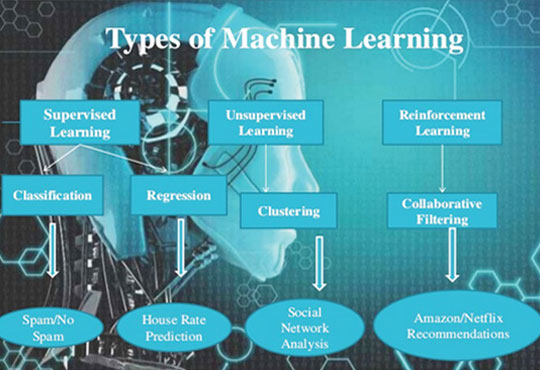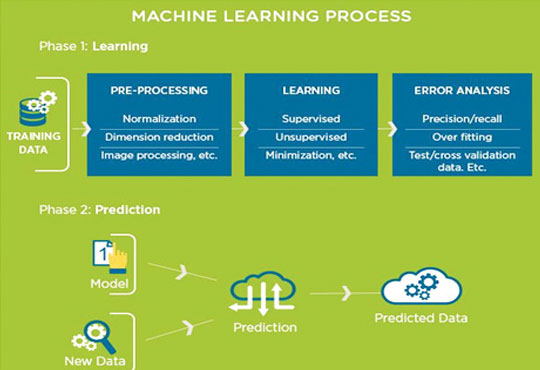
Machine Learning:Taking AI A Step Further
Yogendra Singh, Head - IT, Barista
 Machine Learning is a hot topic right now and everyone is trying to get their hands on any information they can get about ML.
Machine Learning is a hot topic right now and everyone is trying to get their hands on any information they can get about ML.
Machine Learning falls under the umbrella of AI that provided systems with the ability to automatically learn and improve from experience without being explicitly programmed.
The process of learning begins with observation of data, such as examples, direct experience or instruction, in order to look for patterns in data and make better decisions in the future based on the example we provided.
Machine learning, deep learning, artificial intelligence... The science of getting machines to perform actions without explicitly programming them to do so can be intimidating for the uninitiated. These machine learning articles aim to unpack the black box for beginners, with introductions to overall concepts.
Machine Learning, computers find insightful information without being told where to look. Instead, they do this by leveraging algorithms that learn from data in an iterative process.
Machine Learning is undoubtedly one to adapt to new data independently and through iterations. Basically, applications learn from previous computations and transactions and use 'pattern recognition' to produce reliable and informed results.
Machine Learning is, undoubtedly, one of the most exciting subsets of Artificial Intelligence. It completes the task of learning from data with specific inputs to the machine. It's important to understand what makes Machine Learning work and thus how it can be used in the future.
The Machine Learning process starts with inputting training data into the selected algorithm. Training data being known or unknown data to develop the final Machine Learning algorithm. The type of training data input does impact the algorithm and that concept will be covered further momentarily.
Types of Machine Learning
Supervised Learning- Supervised learning is the most popular paradigm for machine learning. It is the easiest to understand and the simplest to implement. It is very similar to teaching a child with the use of flash cards.
Unsupervised Learning- Unsupervised learning is very much the opposite of supervised learning. It features no labels. Instead, our algorithm would be fed a lot of data and given the tools to understand the properties of the data. From there, it can learn to group, cluster and/or organize the data in a way such that a human (or other intelligent algorithm) can come in and make sense of the newly organized data.
Reinforcement Learning- Reinforcement learning is fairly different when compared to supervised and unsupervised learning. Where we can easily see the relationship between supervised and unsupervised(the presence or absence of labels) the relationship to reinforcement learning is a bit murkier. Some people try to tie reinforcement learning closer to the two by describing it as a type of learning that relies on a time dependent sequence of labels, however my opinion is that that simply makes things more confusing.
"Machine learning is one of the latest artificial intelligence technologies where machines can learn by taking in data, analysing it, taking action, and then learning from the results of that action"
Today, artificial intelligence is one of the fastest growing emerging technologies and describes machines that can perform tasks that previously required human intelligence.

Machine learning takes it a step further. It's one of the latest artificial intelligence technologies where machines can learn by taking in data, analysing it, taking action, and then learning from the results of that action.
·In machine learning, a target is called a label.
·In statistics, a target is called a dependent variable.
· A variable in statistics is called a feature in machine learning.
·A transformation in statistics is called feature creation in machine learning.

Why machine learning?
To better understand the uses of Machine Learning, consider some instances where Machine Learning is applied: the self driving Google car cyber fraud detection and online recommendation engines from Facebook, Netflix, and Amazon. Machines can enable all of these things by filtering useful pieces of information and piecing them together based on patterns to get accurate results.
The process flow depicted here represents how Machine Learning works:
What's required to create good machine learning systems?
· Data preparation capabilities.
· Algorithms basic and advanced.
· Automation and iterative processes.
· Scalability.
· Ensemble modelling.
CIO Viewpoint
Why Foolproof Facial Recognition Is Key Against...
By Joseph Sudheer Thumma, Global CEO & MD, Magellanic Cloud
National Technology Day 2025: Powering Progress...
By CIOTech Outlook Team
Aligning IT Roadmap with Business Objectives: A...
By Subhash singh Punjabi, CISO & Head Enterprise Architecture, Deepak Fertilisers & Petrochemicals Corporation Ltd
CXO Insights
Data Management Strategies for AI-Driven...
By Dr. Parul Naib, Head - Data Science and AI, Reserve Bank Innovation Hub
Revolutionizing Financial Services with...
By Srikanth Appana, Chief Technology Officer, Bajaj Auto Credit Ltd
How to Lead Large-Scale Digital Engineering...









.jpg)
.jpg)
.jpg)









